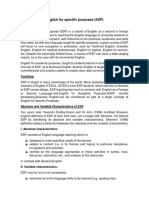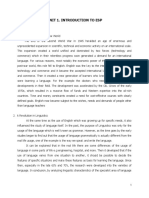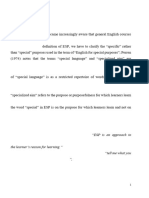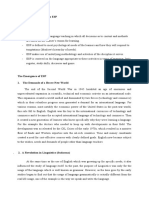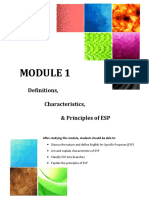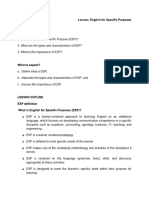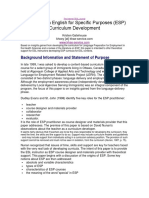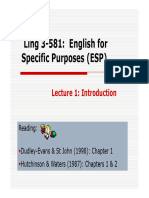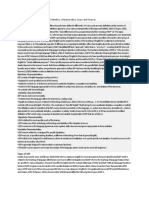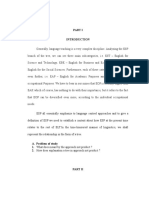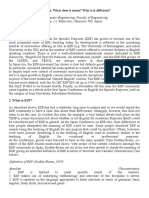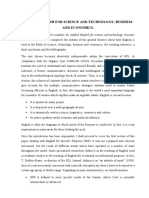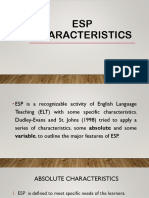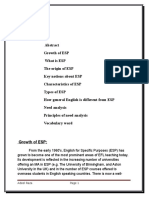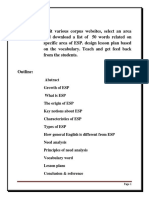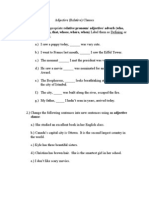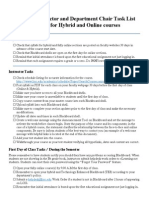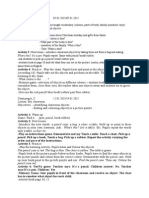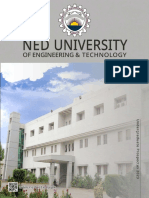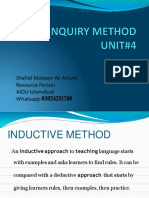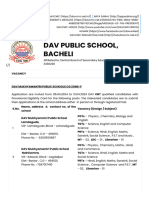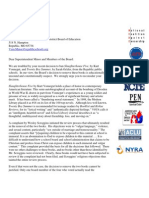Esp Est
Esp Est
Uploaded by
Itzel Paniagua OchoaCopyright:
Available Formats
Esp Est
Esp Est
Uploaded by
Itzel Paniagua OchoaOriginal Title
Copyright
Available Formats
Share this document
Did you find this document useful?
Is this content inappropriate?
Copyright:
Available Formats
Esp Est
Esp Est
Uploaded by
Itzel Paniagua OchoaCopyright:
Available Formats
Step 1. What are the two strong branches that emerged from ESP?
The second type of ESP identified by Carter (1983) is English for Academic and Occupational Purposes. In the 'Tree of ELT' (Hutchinson & Waters, 1987), ESP is broken down into three branches: a) English for Science and Technology (EST), b) English for Business and Economics (EBE), and c) English for Social Studies (ESS). Each of these subject areas is further divided into two branches: English for Academic Purposes (EAP) and English for Occupational Purposes (EOP). What do the authors say that it was clear that the one-size fits all approach to learning English wasnt sufficient anymore? Anthony (1997) notes that there has been considerable recent debate about what ESP means despite the fact that it is an approach, which has been widely used over the last three decades. At a 1997 Japan Conference on ESP, Dudley-Evans offered a modified definition. The revised definition he and St. John postulate is as follows: I. Absolute Characteristics ESP is defined to meet specific needs of the learner; ESP makes use of the underlying methodology and activities of the discipline it serves; ESP is centered on the language (grammar, lexis, register), skills, discourse and genres appropriate to these activities. Dudley-Evans and St. John have removed the absolute characteristic that 'ESP is in contrast with General English' and added characteristics that are more variable. They assert that ESP is not necessarily related to a specific discipline. Furthermore, ESP is likely to be used with adult learners although it could be used with young adults in a secondary school setting. If we revisit Dudley-Evans' (1997) claim that ESP should be offered at an intermediate or advanced level, use of authentic learning materials is entirely feasible. Closer examination of ESP materials will follow; suffice it to say at this juncture that use of authentic content materials, modified or unmodified in form, are indeed a feature of ESP, particularly in self-directed study and research tasks. For Language Preparation for Employment in the Health Sciences, a large component of the student evaluation was based on an independent study assignment in which the learners were required to investigate and present an area of interest. The students were encouraged to conduct research using a variety of different resources, including the Internet. Source; Step 2 define these terms and quote the source English as a restricted language Knowing a restricted language would not allow the speaker to communicate effectively in a novel situation outside of a very specific environment. (Airline stewardess, waiter, air traffic controller etc.) Gatehouse, K. (2001). Key issues in English for specific purposes (ESP) Curriculum. The Internet TESL Journal, 7, 1-11.
English with Specific Topics The third and final type of ESP identified by Carter (1983) is English with specific topics. Carter notes that it is only here where emphasis shifts from purpose to topic. This type of ESP is uniquely concerned with anticipated future English needs of, for example, scientists requiring English for postgraduate reading studies, attending conferences or working in foreign institutions. Step 3. State and define the 3 features all ESP courses have in common ESP courses can be of various types, as you have just seen, but Carter (1983) feels that there are 3 features all ESP courses have in common. Which are they? Types of ESP: According to Carter (1983), there are three types of ESP:1. English as a restricted language: The language used by air traffic controllers or by waiters are examples of English as a restricted language. 2. English for academic and occupational purposes: English for science and technology(EST), English for Business and Economics(EBE), English for social studies(ESS), English for academic purposes(EAP), and English for occupational purposes (EOP). 3. English with specific topics: This type concerned with anticipated future English needs of, for example, scientists requiring English for postgraduate reading studies, attending conferences or working in foreign institutions. They have in common that each one of the above mentioned is for students that want to achieve goals in performing their specific topic knowledge in a second language.
Step 4. Write your own reflection (100 words) on what you make of the following: According to carter students will become users of the language and to become one you have to use authentic materials, purpose related orientation and self- direction that it means that the learning will become autonomous, and meaningful for the learners. But to achieve the learning that I just mention teacher have to be systematic in order to teach students through learning strategies. For example if we teach about laws, we need to find strategies to guide students to link up with the ones they already know in Spanish in order to have a deeper understanding of the specific topic that we want to teach them.
You might also like
- The Origin and Development of Esp The Definition of ESPDocument9 pagesThe Origin and Development of Esp The Definition of ESPBadong Silva100% (2)
- The Origin of EspDocument6 pagesThe Origin of EspNanangSusantoNo ratings yet
- English For Specific Purposes: Its Definition, Characteristics, Scope and PurposeDocument14 pagesEnglish For Specific Purposes: Its Definition, Characteristics, Scope and PurposeChoudhary Zahid Javid100% (10)
- Advantages of Multiculturalism in The Workplace 62440Document2 pagesAdvantages of Multiculturalism in The Workplace 62440Itzel Paniagua Ochoa20% (5)
- GRADES 1 To 12 Daily Lesson Log: I. ObjectivesDocument4 pagesGRADES 1 To 12 Daily Lesson Log: I. ObjectivesAnonymous cdvDnDTNo ratings yet
- (2018) Alterity PDFDocument2 pages(2018) Alterity PDFBruno BartelNo ratings yet
- English For Specific PurposesDocument5 pagesEnglish For Specific PurposesLuis Guillermo BarraNo ratings yet
- English For Specific PurposesDocument5 pagesEnglish For Specific PurposesLuis Guillermo BarraNo ratings yet
- Esp ModuleDocument87 pagesEsp ModuleTricia Marie RemandoNo ratings yet
- ESP LecturesDocument13 pagesESP Lecturesaphroditemelody9704No ratings yet
- It Is Widely Accepted That English Has Become The Language of Choice For Many International CommunityDocument3 pagesIt Is Widely Accepted That English Has Become The Language of Choice For Many International CommunitySilvi AlizaNo ratings yet
- GSGDocument3 pagesGSGSilvi AlizaNo ratings yet
- Areas of EspDocument3 pagesAreas of EspNawalNo ratings yet
- Absolute and Variable Characteristics of ESPDocument2 pagesAbsolute and Variable Characteristics of ESPNiño Embile Dellomas100% (13)
- Unit 1Document9 pagesUnit 1Ольга СавкоNo ratings yet
- Defining English For Specific Purposes and The Role of The ESP PractitionerDocument3 pagesDefining English For Specific Purposes and The Role of The ESP PractitionerAfida Mohamad AliNo ratings yet
- English For Medical Purposes Course Design For Arab University StudentsDocument21 pagesEnglish For Medical Purposes Course Design For Arab University StudentsAbu Ubaidah50% (2)
- Esp TOPICSDocument11 pagesEsp TOPICSSherene Jane PapellerasNo ratings yet
- LESSON 1 Introduction To ESPDocument4 pagesLESSON 1 Introduction To ESPCarmie Lactaotao Dasalla100% (2)
- Specificity of ITDocument18 pagesSpecificity of ITptkduongNo ratings yet
- Chapter 1 Summary4Document5 pagesChapter 1 Summary4Amalia AsokawatiNo ratings yet
- Definitions, Characteristics, & Principles of ESPDocument20 pagesDefinitions, Characteristics, & Principles of ESPLan Anh TạNo ratings yet
- The Origin and Development of EspDocument5 pagesThe Origin and Development of EspMusesSMLNo ratings yet
- Meeting 2 Concept of ESPDocument18 pagesMeeting 2 Concept of ESPOlivia KarynNo ratings yet
- English For Specific Purposes: What Does It Mean? Why Is It Different? A. Growth of ESPDocument6 pagesEnglish For Specific Purposes: What Does It Mean? Why Is It Different? A. Growth of ESPMILCAH PARAYNONo ratings yet
- English For Specific PurposesDocument2 pagesEnglish For Specific PurposesFarahVauseNo ratings yet
- report on tespDocument5 pagesreport on tespJoshua ApolonioNo ratings yet
- Module 1 Esp: History and Design Lesson 1 Origins of EspDocument19 pagesModule 1 Esp: History and Design Lesson 1 Origins of EspMaris daveneNo ratings yet
- Esp Defining English For Specific Purpose and The Role of Esp PractitionerDocument5 pagesEsp Defining English For Specific Purpose and The Role of Esp PractitionerImam Syafi'i0% (1)
- Written ReportDocument5 pagesWritten ReportJie em AgutayaNo ratings yet
- Classification of ESP: Examples of English CoursesDocument6 pagesClassification of ESP: Examples of English CoursesCarlos GilNo ratings yet
- English Specific Purposes Curriculum DevelopmentDocument12 pagesEnglish Specific Purposes Curriculum DevelopmentjohnferneyNo ratings yet
- English For Specific PurposesDocument17 pagesEnglish For Specific PurposesAhmad Bilal100% (1)
- For Reflection, ESPDocument33 pagesFor Reflection, ESPTrisa Langamon100% (1)
- Ling 3-581 - Lecture 1Document34 pagesLing 3-581 - Lecture 1Nur AzizahNo ratings yet
- English For Specific PurposesDocument2 pagesEnglish For Specific Purposessuriati sulaimanNo ratings yet
- Esp PaperDocument10 pagesEsp PaperHena OktalianaNo ratings yet
- English For Specific PurposesDocument3 pagesEnglish For Specific PurposesCarol SsqNo ratings yet
- (Nation .Citation NeededDocument32 pages(Nation .Citation Neededtitima1zouzouNo ratings yet
- Unit 38. English For Science and Technology, Business and EconomicsDocument6 pagesUnit 38. English For Science and Technology, Business and EconomicsLucía RGNo ratings yet
- Esp and EgpDocument4 pagesEsp and EgpAnca IonescuNo ratings yet
- Final Ebook Esp 2018 Made by Batch 2014+2015Document199 pagesFinal Ebook Esp 2018 Made by Batch 2014+2015Faizal RisdiantoNo ratings yet
- Gatehouse - Key Issues in English for Specific Purposes (ESP) Curriculum DevelopmentDocument9 pagesGatehouse - Key Issues in English for Specific Purposes (ESP) Curriculum DevelopmentEugenia CabralNo ratings yet
- Uas English For Specific PurposesDocument10 pagesUas English For Specific PurposesMuhammad Shofyan IskandarNo ratings yet
- Makalah ESPDocument10 pagesMakalah ESPica100% (1)
- Synthesis PaperDocument8 pagesSynthesis PaperAbuRakan1 GamilNo ratings yet
- 03 ESP CharacteristicsDocument15 pages03 ESP CharacteristicsAlvin GacerNo ratings yet
- Zhu 2014 Study On The Theoretical Foundation of Business English Curriculum DesignDocument7 pagesZhu 2014 Study On The Theoretical Foundation of Business English Curriculum DesigntoiyeutienganhNo ratings yet
- English For Specific Purposes Review of LiteratureDocument19 pagesEnglish For Specific Purposes Review of LiteratureAji Handoko100% (4)
- Outline:: Adeel RazaDocument23 pagesOutline:: Adeel RazaAdeel RazaNo ratings yet
- ESPDocument4 pagesESPLily Ienna100% (2)
- The Basic Concept of English For Specific PurposesDocument3 pagesThe Basic Concept of English For Specific Purposesishakishak7No ratings yet
- Reporting ReviewerDocument26 pagesReporting ReviewerSTEPHANIE ANNE DACALANIONo ratings yet
- The Paper of Introduction To EspDocument12 pagesThe Paper of Introduction To EspFoodLoverNo ratings yet
- Esp As An Approach of English Language Teaching in ItsDocument10 pagesEsp As An Approach of English Language Teaching in ItsZiyaNo ratings yet
- TaskDocument23 pagesTaskMaria Victoria PadroNo ratings yet
- Esp and EopDocument4 pagesEsp and Eopusama200475% (4)
- An Introduction To ESP LAMRIDocument24 pagesAn Introduction To ESP LAMRIناصر الإسلام خليفي50% (2)
- ESP AssignmentDocument10 pagesESP Assignmentshin hye PaladinoNo ratings yet
- ELT Basics: A Beginner’s Guide to English Language TeachingFrom EverandELT Basics: A Beginner’s Guide to English Language TeachingNo ratings yet
- The 6 Principles for Exemplary Teaching of English Learners: Academic and Other Specific PurposesFrom EverandThe 6 Principles for Exemplary Teaching of English Learners: Academic and Other Specific PurposesNo ratings yet
- Adjective Order Quiz - Grammar - EnglishClubDocument1 pageAdjective Order Quiz - Grammar - EnglishClubItzel Paniagua OchoaNo ratings yet
- Ntroduce The Past Perfect With A TimelineDocument3 pagesNtroduce The Past Perfect With A TimelineItzel Paniagua OchoaNo ratings yet
- Bingo For Number PronunciationDocument4 pagesBingo For Number PronunciationItzel Paniagua OchoaNo ratings yet
- Can, Could, May and Might AnswersDocument6 pagesCan, Could, May and Might AnswersItzel Paniagua OchoaNo ratings yet
- Can, Could, May and Might AnswersDocument6 pagesCan, Could, May and Might AnswersItzel Paniagua OchoaNo ratings yet
- Countable UncountableDocument6 pagesCountable UncountableItzel Paniagua OchoaNo ratings yet
- Adjective Clauses Student VersionDocument2 pagesAdjective Clauses Student VersionItzel Paniagua Ochoa0% (2)
- Love Potion NoDocument1 pageLove Potion NoItzel Paniagua OchoaNo ratings yet
- Gotye - Somebody That I Used To Know: Slang GlossaryDocument2 pagesGotye - Somebody That I Used To Know: Slang GlossaryItzel Paniagua OchoaNo ratings yet
- Design A Marking Code To Mark Ss Writing. Introduce Code To Ss. Use It To GradeDocument1 pageDesign A Marking Code To Mark Ss Writing. Introduce Code To Ss. Use It To GradeItzel Paniagua OchoaNo ratings yet
- Prepositions of Place Flashcards Monkey PDFDocument5 pagesPrepositions of Place Flashcards Monkey PDFItzel Paniagua OchoaNo ratings yet
- The Logical SongDocument4 pagesThe Logical SongItzel Paniagua OchoaNo ratings yet
- Jee Main ResultDocument2 pagesJee Main Resultburhanbashir222No ratings yet
- The 6 Traits of Writing: Ideas Organization Word Choice Sentence Fluency Voice ConventionsDocument17 pagesThe 6 Traits of Writing: Ideas Organization Word Choice Sentence Fluency Voice ConventionsdhanuNo ratings yet
- Course Start Instructor Task Lists Checklist Blackboard Updated 04-17-14Document2 pagesCourse Start Instructor Task Lists Checklist Blackboard Updated 04-17-14api-253788866No ratings yet
- Edee 492 Assignment 1 - sp24 1Document8 pagesEdee 492 Assignment 1 - sp24 1api-739659545No ratings yet
- What's This? It's A Pen. Pupils Repeat. Same With Pencil/ Book/ RubberDocument2 pagesWhat's This? It's A Pen. Pupils Repeat. Same With Pencil/ Book/ RubberBlanka MazuchNo ratings yet
- UGProspectus 2023Document125 pagesUGProspectus 2023TaimoorNo ratings yet
- Milestone 1 For WebsiteDocument7 pagesMilestone 1 For Websiteapi-238992918No ratings yet
- Lesson Plan Mathematics Week 3Document5 pagesLesson Plan Mathematics Week 3Thesa NainggolanNo ratings yet
- 21st Century Skills Map: Designed in Cooperation With The Nation'S World Language EducatorsDocument21 pages21st Century Skills Map: Designed in Cooperation With The Nation'S World Language EducatorsDon DoehlaNo ratings yet
- Shahid Mobeen Ali Anjum Resource Person AIOU Islamabad Whatsapp:03024251700Document13 pagesShahid Mobeen Ali Anjum Resource Person AIOU Islamabad Whatsapp:03024251700Alpha ProductionNo ratings yet
- Ubc 2009 Fall Shason Jan-PaulDocument154 pagesUbc 2009 Fall Shason Jan-PaulNiña Anne DelaCruz RamosNo ratings yet
- Liu 2017Document23 pagesLiu 2017elypuspitasari2020No ratings yet
- Guest Editorial: Ijem 32,2Document4 pagesGuest Editorial: Ijem 32,2cansuNo ratings yet
- Native American Creation StoriesDocument14 pagesNative American Creation StoriesadaletNo ratings yet
- AmitPhadikar ResumeDocument7 pagesAmitPhadikar ResumeengineeringwatchNo ratings yet
- Online Education Vs Physical EducationDocument13 pagesOnline Education Vs Physical EducationChalani Maheshika0% (1)
- Literature Review On Housing ProblemsDocument7 pagesLiterature Review On Housing Problemsfvf3f9h1100% (1)
- Values EducationDocument8 pagesValues Educationeugene rey saromines100% (1)
- Personal Information Bianca David: First Name/ SurnameDocument3 pagesPersonal Information Bianca David: First Name/ SurnameVictor ConstantinNo ratings yet
- Stage 8 - 2.11 - Lessonplan Collins Y8 Teacher's GuideDocument1 pageStage 8 - 2.11 - Lessonplan Collins Y8 Teacher's GuideAya Ahmed QotbNo ratings yet
- Source, Message and Channel FactorsDocument22 pagesSource, Message and Channel FactorsPrince DiuNo ratings yet
- HEC Merit and Need Based Scholarship 2023-24Document6 pagesHEC Merit and Need Based Scholarship 2023-24Star MobileNo ratings yet
- D.A.V. Public School, BacheliDocument3 pagesD.A.V. Public School, Bacheliaradhana1631No ratings yet
- Letter Re: Republic, MO Banning of Slaughterhouse 5Document4 pagesLetter Re: Republic, MO Banning of Slaughterhouse 5ncacensorshipNo ratings yet
- Career Exploration and Self Assessment Summary Page InstructionsDocument4 pagesCareer Exploration and Self Assessment Summary Page Instructionsapi-322059527No ratings yet
- Southeast University: ( Name & Father's Name Should Be Written As Per SSC or Its Equivalent Certificate.)Document1 pageSoutheast University: ( Name & Father's Name Should Be Written As Per SSC or Its Equivalent Certificate.)Asm Razi KhanNo ratings yet
- The Effects of Facebook in Examination of The Students in Core SubjectDocument16 pagesThe Effects of Facebook in Examination of The Students in Core SubjectSean Ray Sicad BongansisoNo ratings yet
- Comparatives and Superlatives Card Game: Activity TypeDocument3 pagesComparatives and Superlatives Card Game: Activity TypeThu ThuNo ratings yet







